 klaus-michael schneider
klaus-michael schneider
Keywords: education |
Links: FOTW homepage | search | disclaimer and copyright | write us | mirrors

Last modified: 2021-08-26 by  klaus-michael schneider
klaus-michael schneider
Keywords: education |
Links: FOTW homepage |
search |
disclaimer and copyright |
write us |
mirrors
See also:
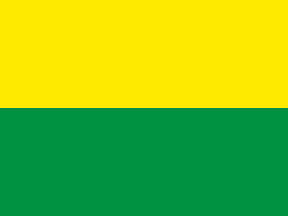 image by Eugene Ipavec, 20 February 2006
image by Eugene Ipavec, 20 February 2006
Some background from the university website:
"The Colombian Polytechnic Jaime Isaza Cadavid is a Public
University Institution, funded by the departmental government of
Antioquia. Founded in 1964, the Polytechnic now caters for
approximately 13,200 students. The main campus is situated in El
Poblado, in the city of Medellín, and counts on 1,300
educational and 350 administrative staff, as well as its
three academic centers in other municipalities of the department
of Antioquia.
The Polytechnic is a national leader in technological education
and at present offers higher education at technological,
technical and academic levels with a range of undergraduate and
postgraduate courses in areas such as Engineering,
Administration, Agrarian Sciences, Audiovisual Communication,
Sport and Recreation. These programs are supplemented by various
extension, continued education and informal courses available to
the general public."
"Poli" is named after Jaime Isaza Cadavid (1919-1965).
Cadavid studied in the Faculty of Law of the University of
Antioquia. He had liberal leanings and was elected Deputy at the
Departmental Assembly of Antioquia, (Municipal?) Councillor in
Fredonia and Antioquia, Deputy at the Chamber and Senator of the
Republic. He served as Dean and Professor ad Honorem in the
Faculty of Law of the University of Medellín. He significantly
contributed to the foundation of "Poli"; by Order 11 of
30 November 1965, his name was given to "Poli" as a
posthumous tribute.
The flag of "Poli" recalls the shield of the
University, which is per fess or and vert with additional
charges. Or/yellow symbolizes strength of the students whereas
Vert/green symbolizes hope and confidence in the future.
Source: www.politecnicojic.edu.co,
located by Valentin Poposki, 18 February 2006.
Ivan Sache, 25 February 2006.and 20 December 2008
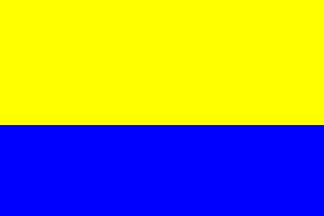 image by Ivan Sache, 16 September 2014
image by Ivan Sache, 16 September 2014
Institución Educativa Javiera Londono was established in 1949 in Medellín (Antioquia
Department). The institute is named for Javiera Londono (1696-1767). Born in
Medellín, she spent her life in the valley of San Nicolás de Rio Negro; in spite
of being of wealthy and noble ascent, she did not receive any education and
could not sign her name. When very young, she married Captain Ignacio Castañeda
and subsequently inherited his goods, including the best stables in the region.
Without children, she liberated her slaves short before her death and
transferred to them the mines she owned in the neighbourhood. She also
bequeathed part of her fortune to the municipalities of Rio Negro and Marinilla
to improve education.
The flag of the institute is horizontally divided yellow-blue, the yellow stripe
being "higher". Yellow represents wealth, like on the national coat of arms,
harmony, science, social interaction, and social projection. Blue is a symbol of
measure and prudence, and of the immense sea of integral education on which
flies the institute's flag.
Ivan Sache, 16 September 2014
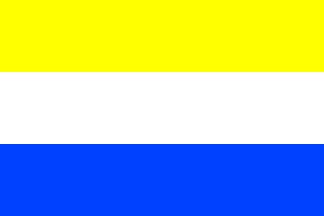 image by Carlos Thompson, 27 May 2003
image by Carlos Thompson, 27 May 2003
"Pontificia Universidad Javeriana" is a catholic university dated from
1621. You can find the flag and symbols of this university www.javeriana.edu.co.
Jorge Eduardo Alonso, 8 June 2002
The flag of the University is made of three horizontal stripes
yellow, white and blue, of equal width. The flag is prescribed
by General Regulation #794.
As pointed out by Jorge, the University has a very long history,
divided into two distinct periods:
1621-1767 - Pope Gregor XV allowed the Jesuits to found
universities in South America by a brief dated 9 July 1621. The
"Academia de San Francisco Javier", named after St.
Francis-Xavier, was confirmed by an order of King of Spain Philip
III dated 2 March 1622. On 23 June 1704, Pope Clement XII granted
the "Academia" the title of "Public
University". The first period of the University ended on 1
July 1767, when King of Spain Charles III expelled the Jesuits
from his dominions.
1930 - The University was reestablished on 1 October 1930. On 31
July 1937 (St. Ignatius of Loyola's Day), the University was
granted by the Holy See the title of "Pontifical
University". Its current statute was approved by the Holy
See on 27 April 1978 and by Resolution # 5117, dated 16 May 1985,
signed by the Minister of National Education of Columbia.
Ivan Sache, 9 June 2002
Concering Pontificia Universidad Javeriana, Bogotá, the site just says
"blue", but the shade I have always seen flying is light sky blue (together with
the Vatican and Colombian flags). Pontificia Universidad Javeriana, Cali, Valle
del Cauca is actually the same University as Javeriana Bogotá, but has a lot of
autonomy. The symbols, including the flag, are the same. In the
website www.puj.edu.co
they do use the light shade of blue.
Carlos Thompson, 27 May 2003
I study at the PUJ and the flag that I've seen, which is flown
rarely (at beginning of semesters, when an important jesuit dies
etc.), use the same shade of blue than that of the Colombia flag.
Jaime Vengoechea, 10 June 2003
I am based mostly on memory (I am Javeriano too) and on these pictures: sparta.javeriana.edu.co//img1.jpg
and img5.jpg.
Carlos Thompson, 10 June 2003
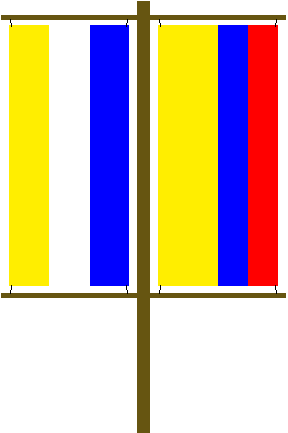 image by Carlos Thompson, 22 July 2003
image by Carlos Thompson, 22 July 2003
I was today at my University and it was an interesting display
of flags. On each pole set, they had flying the flags of Colombia
(in the middle), the University (at the viewers left) and the
Vatican (without the charge: plain yellow and white per pale; at
the right). Also, on every mast there was two vertical flags
framed: the University's and the Colombian flag. (Javeriana
flag at viewers left, and top to the left in both flags).
The shade of blue on all those flags was the same shade as the
Colombian flag (some times it seem slightly lighter, but
definitively it was not sky blue).
Carlos Thompson, 22 July 2003
Variant with arms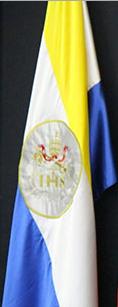 image located by Esteban Rivera, 24 February 2017
image located by Esteban Rivera, 24 February 2017
A variant features the University's coat of arms (colored version) (http://www.javeriana.edu.co/...escudo%20color.jpg)
in the middle. it was seen in a tv news report two days ago by CM&:.
The
flag is also seen here:
http://www.javeriana.edu.co/ (source:
http://www.javeriana.edu.co).
For further information, here's the
official University's website on symbols and regulations:
http://www.javeriana.edu.co/institucional/simbolos-y-emblemas
Esteban Rivera, 24 February 2017
The Unidad Educativa Jean Piaget (Jean Pieaget Educational Unit) is a high
school located in Bogotá, established in 1977.
Source:
http://www.uejeanpiaget.edu.co/sitio/index.php/nuestro-colegio/horizonte-institucional/historia
The flag is the logo (http://www.uejeanpiaget.edu.co/sitio/images/logo-jeanpiaget.png)
over a white horizontal flag as seen here:
http://www.uejeanpiaget.edu.co/sitio/images/simboolosuejp.jpg (source:
http://www.uejeanpiaget.edu.co/sitio/index.php/nuestro-colegio/nuestros-simbolos)
For additional information go to UEJP (official website):
http://www.uejeanpiaget.edu.co/
Esteban Rivera, 31 January 2017
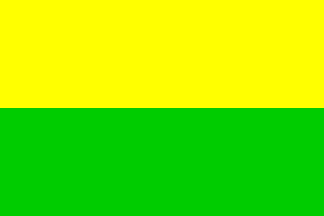 image by Ivan Sache, 5 February 2009
image by Ivan Sache, 5 February 2009
"Colegio Parroquial 'Jesús de la Buena Esperanza'"
(Jesus of Good Hope) was founded in 1959 by Priest Carlos Gustavo
Pérez Mejía (1918-1976) in Bello, Department of Antioquia.
The flag of the institute, as shown graphically and described on
the website
of the institute, is horizontally divided yellow-green.
Yellow represents wisdom, wealth and the Eucharist. Green
represents hope, liberty and joy.
Ivan Sache, 5 February 2009
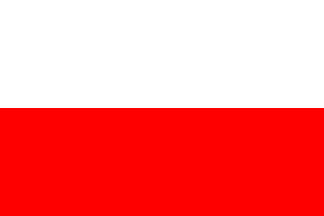 image by Ivan Sache, 17 March 2015
image by Ivan Sache, 17 March 2015
Colegio Jesús María (official name Comunidad Colegio Jesús-María, Jesus Mary
Community High School) was established in Medellín ( Jesus Mary High School ) in
1958 inspired by the teachings of Saint Claudine Thévenet ,as a Catholic school.
Source:
http://www.jesusmariamed.edu.co/index.php?option=com_content&view=article&id=55:quienes-somos&catid=2:contenido-base&Itemid=120
Its flag is a horizontal white over red flag, in equally divided stripes, as
seen here.
Source:
http://www.jesusmariamed.edu.co/index.php?option=com_content&view=article&id=54:simbolos&catid=2:contenido-base&Itemid=120
.
It may sometimes be charged with the respective
coat of arms, as their official website states.
Picture taken outside the main entrance of
the school,
on March 12, 2015). Notice the
Antioquia Department flag on the left, and
behind it, the school's flag.
For additional information go to: Colegio Jesús María (official website)
Esteban Rivera, 17 March 2015
Colegio Franciscano Jiménez de Cisneros, located in Ibagüé (Tolima), is named
for Cardinal Francisco Jiménez de Cisneros (1436-1517), religious reformer
during the reign of the Catholic Monarchs in Spain and founder of the
Complutense University.
The flag of Colegio Franciscano Jiménez de
Cisneros is horizontally divided yellow-green.
Yellow represents the
spiritual and academic resources of each member of the educational community.
Green represents aspiration to fraternity with the natural environment, which is
a vital part of life, as taught by St. Francis of Assisi.
http://www.colegiocisneros.edu.co/new/index.php/joomla/contentall-comcontent-views/category-list-2
School website
Ivan Sache, 1 January 2021
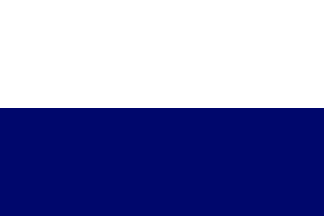 image by Ivan Sache, 17 June 2018
image by Ivan Sache, 17 June 2018
Institución Educativa Técnica Jiménez de Quesada is located in
Armero-Guayabal (Tolima Department). It is composed of two urban (Jiménez de
Quesada and Diana Turbay) and three rural (Maracaibo, Méndez and San Jorge)
seats.
The school is named for the conquistador Gonzalo Jiménez de Quesada (1509-1579),
who explored New Granada and founded Santa Fé de Bogotá in 1538. The expedition
he led in 1568 in search of the legendary El Dorado ended in a disaster.
Source: IET Jiménez de
Quesada website
The flag of IET Jiménez de Quesada, adopted on 29 August 1992 during a teachers'
meeting, is horizontally divided white-blue.
White exalts greatness and clearness.
Blue means the immensity of knowledge.
Source:
IET
Jiménez de Quesada website
Ivan Sache, 17 June 2018
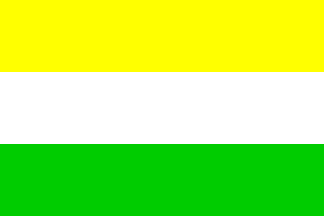 image by Ivan Sache, 7 February 2009
image by Ivan Sache, 7 February 2009
"Institución Educativa 'Joaquín de Cayzedo y Cuero'" was founded, as "Colegio
del Barrio Cristóbal Colón", affiliated to "Instituto Politécnico Municipal", in
Borough Cristóbal Colón, Municipality of Cali, Department of Valle del Cauca, on
15 October 1964 (Decree No. 0750). On 8 March 1965 (Decree No. 0623), the
institute was renamed "Colegio 'Joaquín de Cayzedo y Cuero'"; on 8 April 1966
(Decree No. 0406), it became independent from "Instituto Politécnico Municipal".
The institute is named after the politician Joaquín de Cayzedo y Cuero, who
presided the Extraordinary Assembly that gathered in Cali on 3 July 1810 and
issued what is often, seemingly erroneously, considered as the first
independence declaration of Colombia. See: www.elpais.com.co.
The flag of the institute, as shown graphically
and on a photo
on the website of the institute, is horizontally divided
yellow-white-green.
Ivan Sache, 7 February 2009
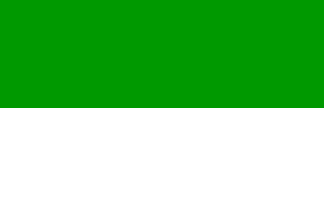 image by Ivan Sache, 30 January 2009
image by Ivan Sache, 30 January 2009
"Institución Educativa Técnica 'Joaquín París'"
was created at Ibagué, Department of Tolima, on 2 October 2002
(Decree No. 1216), transforming "Centro Auxiliar de
Servicios Docentes de Ibagué" into a full-fledged
educational institute. General Joaquín París y Ricaurte
(1795-1862), a hero of the War of Independence, was appointed
Vice-President of Colombia in 1855. On 24 June 1983, for the
celebration of the 200th anniversary of Simón Bolívar, the
names of several of his brothers-in-arms were given to
educational institutes.
The flag of the institute, as shown graphically on the website
of the institute, is horizontally divided green-white.
Ivan Sache, 30 January 2009